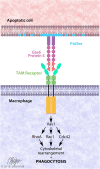Targeting Tyro3, Axl and MerTK (TAM receptors): implications for macrophages in the tumor microenvironment
- PMID: 31088471
- PMCID: PMC6515593
- DOI: 10.1186/s12943-019-1022-2
Targeting Tyro3, Axl and MerTK (TAM receptors): implications for macrophages in the tumor microenvironment
Abstract
Tumor-associated macrophages are an abundant cell type in the tumor microenvironment. These macrophages serve as a promising target for treatment of cancer due to their roles in promoting cancer progression and simultaneous immunosuppression. The TAM receptors (Tyro3, Axl and MerTK) are promising therapeutic targets on tumor-associated macrophages. The TAM receptors are a family of receptor tyrosine kinases with shared ligands Gas6 and Protein S that skew macrophage polarization towards a pro-tumor M2-like phenotype. In macrophages, the TAM receptors also promote apoptotic cell clearance, a tumor-promoting process called efferocytosis. The TAM receptors bind the "eat-me" signal phosphatidylserine on apoptotic cell membranes using Gas6 and Protein S as bridging ligands. Post-efferocytosis, macrophages are further polarized to a pro-tumor M2-like phenotype and secrete increased levels of immunosuppressive cytokines. Since M2 polarization and efferocytosis are tumor-promoting processes, the TAM receptors on macrophages serve as exciting targets for cancer therapy. Current TAM receptor-directed therapies in preclinical development and clinical trials may have anti-cancer effects though impacting macrophage phenotype and function in addition to the cancer cells.
Keywords: Axl; Efferocytosis; M2 macrophage polarization; Macrophage; MerTK; TAM receptors; Tyro3.
Conflict of interest statement
Ethics approval and consent to participate
Not applicable.
Consent for publication
Not applicable.
Competing interests
The authors declare that they have no competing interests.
Publisher’s Note
Springer Nature remains neutral with regard to jurisdictional claims in published maps and institutional affiliations.
Figures




References
-
- Siegel RL, Miller KD, Jemal A. Cancer statistics, 2019. CA Cancer J Clin. 2019. - PubMed
Publication types
MeSH terms
Substances
Grants and funding
LinkOut - more resources
Full Text Sources
Other Literature Sources
Research Materials
Miscellaneous

